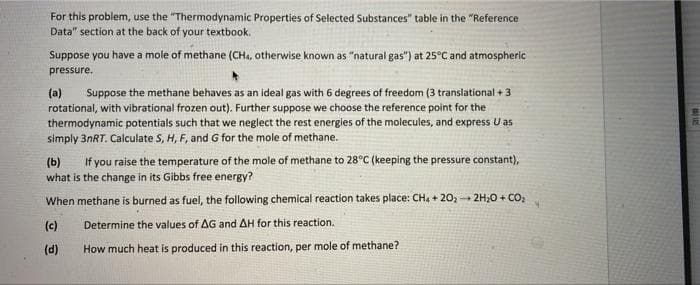For this problem, use the "Thermodynamic Properties of Selected Substances" table in the "Reference Data" section at the back of your textbook. Suppose you have a mole of methane (CH, otherwise known as "natural gas") at 25°C and atmospheric pressure. Suppose the methane behaves as an ideal gas with 6 degrees of freedom (3 translational +3 (a) rotational, with vibrational frozen out). Further suppose we choose the reference point for the thermodynamic potentials such that we neglect the rest energies of the molecules, and express U as simply 31RT. Calculate s, H, F, and G for the mole of methane. (b) what is the change in its Gibbs free energy? If you raise the temperature of the mole of methane to 28°C (keeping the pressure constant), When methane is burned as fuel, the following chemical reaction takes place: CH, + 20, - 2H;0 + CO, (c) Determine the values of AG and AH for this reaction. (d) How much heat is produced in this reaction, per mole of methane?
For this problem, use the "Thermodynamic Properties of Selected Substances" table in the "Reference Data" section at the back of your textbook. Suppose you have a mole of methane (CH, otherwise known as "natural gas") at 25°C and atmospheric pressure. Suppose the methane behaves as an ideal gas with 6 degrees of freedom (3 translational +3 (a) rotational, with vibrational frozen out). Further suppose we choose the reference point for the thermodynamic potentials such that we neglect the rest energies of the molecules, and express U as simply 31RT. Calculate s, H, F, and G for the mole of methane. (b) what is the change in its Gibbs free energy? If you raise the temperature of the mole of methane to 28°C (keeping the pressure constant), When methane is burned as fuel, the following chemical reaction takes place: CH, + 20, - 2H;0 + CO, (c) Determine the values of AG and AH for this reaction. (d) How much heat is produced in this reaction, per mole of methane?
Physical Chemistry
2nd Edition
ISBN:9781133958437
Author:Ball, David W. (david Warren), BAER, Tomas
Publisher:Ball, David W. (david Warren), BAER, Tomas
Chapter18: More Statistical Thermodynamics
Section: Chapter Questions
Problem 18.17E
Related questions
Question

Transcribed Image Text:For this problem, use the "Thermodynamic Properties of Selected Substances" table in the "Reference
Data" section at the back of your textbook.
Suppose you have a mole of methane (CH., otherwise known as "natural gas") at 25°C and atmospheric
pressure.
(a)
rotational, with vibrational frozen out). Further suppose we choose the reference point for the
thermodynamic potentials such that we neglect the rest energies of the molecules, and express U as
simply 3NRT. Calculate S, H, F, and G for the mole of methane.
Suppose the methane behaves as an ideal gas with 6 degrees of freedom (3 translational + 3
If you raise the temperature of the mole of methane to 28°C (keeping the pressure constant),
(b)
what is the change in its Gibbs free energy?
When methane is burned as fuel, the following chemical reaction takes place: CH, + 20, - 2H;0 + CO,
(c)
Determine the values of AG and AH for this reaction.
(d)
How much heat is produced in this reaction, per mole of methane?
Expert Solution
This question has been solved!
Explore an expertly crafted, step-by-step solution for a thorough understanding of key concepts.
This is a popular solution!
Trending now
This is a popular solution!
Step by step
Solved in 2 steps with 2 images

Knowledge Booster
Learn more about
Need a deep-dive on the concept behind this application? Look no further. Learn more about this topic, chemistry and related others by exploring similar questions and additional content below.Recommended textbooks for you

Physical Chemistry
Chemistry
ISBN:
9781133958437
Author:
Ball, David W. (david Warren), BAER, Tomas
Publisher:
Wadsworth Cengage Learning,

Physical Chemistry
Chemistry
ISBN:
9781133958437
Author:
Ball, David W. (david Warren), BAER, Tomas
Publisher:
Wadsworth Cengage Learning,